#mig 1.42
Explore tagged Tumblr posts
Text

MiG 1.42
Information and pictures on the aircraft, MiG 1.42.
22 notes
·
View notes
Text
FLIGHTLINE: 196 - MIG 1.44/1.42 (FLATPACK/FOXGLOVE)
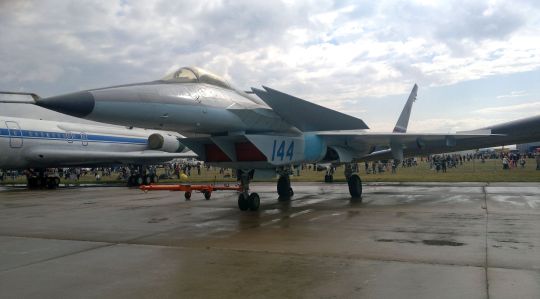
- The MiG 1.44 demonstrator on display at the 2015 MAKS show. | Photo: Hornet Driver
Intended as an answer to the US's Advanced Technology Demonstrator, the MiG 1.44 stumbled through a long gestation, then was unceremoniously canceled.
The USAF's Advanced Technology Demonstrator program sought to replace the F-15 Eagle, and the Air Force's requirements included a number of cutting edge technologies such as supercruise (the ability to travel at Mach 1+ without afterburner) and stealth. The Soviet Union took note of the program, and set its OKBs (Опытное конструкторское бюро" – Opytnoye Konstruktorskoye Byuro, "Experimental Design Bureau") to work designing a replacement for the Su-27 that would challenge the new US jet. The MiG OKB set to work designing two aircraft, a light fighter (LFI - Lyogkiy Frontovoy Istrebitel, "Light Frontline Fighter"), and a multirole heavy aircraft (MFI - Mnogofunksionalni Frontovoy Istrebitel, "Multifunctional Frontline Fighter"). Tests were carried out at TsAGI (Tsentralniy Aerogidrodinamicheskiy Institut, "Central Aero- and Hydrodynamic Institute") to refine the designs of both aircraft, which included canards and delta wings in an aerodynamically unstable design, which is useful for improving agility. As the programs progressed, MiG settled on an intake ramp below the cockpit, with variable geometry ramps to control airflow and thrust vectoring nozzles on the engines, which improved both maneuverability and short takeoff performance. Further testing at TsAGI validated the designs' estimated radar cross-sections and flight profiles. In 1987 MiG submitted both the LFI and MFI for official VVS (Soviet Air Force) review. While both aircraft were approved, MiG dropped the LFI project to concentrate dwindling funding on the MFI, now designated Isdeliye ("Item") 1.42. Testing advanced to radio-controlled wind tunnel models, which showed that the 1.42's design was controllable at angles of attack approaching 60°. By 1988 the specifications of the MFI had been set, and second review by the VVS was completed in 1991, with MiG being given the go-ahead to begin construction of a full-scale technology demonstrator, designated the MiG 1.44.
SPECIFICATIONS
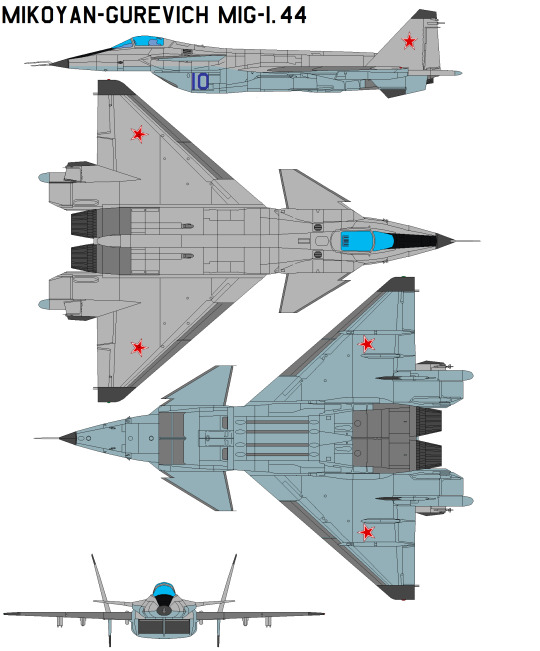
-Orthograph of the MiG 1.44 MFI. | Illustration: bagera3005
The MiG 1.44 was a twin-tailed, canard and delta winged fifth-generation multirole fighter design, although some elements of its design are unconfirmed due to the cancellation of the program. It is known that the airframe was of aluminum-lithium alloy (35%), steel and titanium alloy (30%), composite (30%) and other material (5%) construction. The aircraft was 21.7 meters long, with a wingspan of 17 meters and a height of 4.5 meters. Empty weight was 18,000kg, while design max takeoff weight was to be 37,000 kilos, with a fuel capacity of 13,000kg. The twin vertical stabilizers continued below the wing, with the upper portions canted outwards (likely for RCS control). The two AL-41F afterburning variable-bypass turbofans, designed for the MFI project, produced 177 kN of thrust, which was expected to push the 1.42 to a maximum speed of 2,480kmh (Mach 2.35) at 17,000 meters altitude, with a supercruise of Mach 1.5. The intake ramps and ducts were lined with radar-absorbent material (RAM) to reduce the aircraft's RCS. The exhaust nozzles were lined with ceramic tiles to reduce the infrared signature of the MFI, and could be asymmetrically vectored in both pitch and yaw planes, which was anticipated to give the 1.44/1.42 great maneuverability and STOL performance.
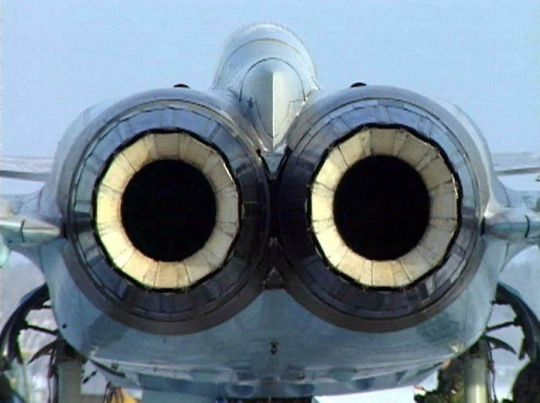
-The exhaust nozzles of the AL-41F turbofans. The lighter inner portions are the ceramic tiles. | Photo: Military Parade
Range was estimated at 4,000km, although if that is with or without stores is unclear. The production 1.42 would have been armed with a 30mm GSh-30-1 autocannon, as well as R-37, -73 and -77 air-to-air missiles in an internal weapons bay, as well as an undetermined suite of ground attack munitions. Munitions and auxiliary fuel tanks could be carried under the wings as well, at the cost of increasing the RCS. The 1.44's cockpit (painted the de rigueur VVS turquoise) featured all digital controls and displays, with an integrated computer-stabilized fly-by-wire system. The 1.42 was projected to have an N014 radar, which had a passive electronically scanned array antenna with Pulse-Doppler look-down, shoot-down capacity. Range of the radar was estimated at 420km, and the system was able to track 40 targets while attacking 20.
NEARLY TEN YEARS WAIT FOR LESS THAN FORTY MINUTES OF FLYING...
Construction of the 1.44 was approximately 50% complete when the USSR collapsed in 1991, which led to an indefinite freeze of the MFI program. Some static test articles, including a full mockup, were completed, which enabled MiG to undertake some testing while the tech demonstrator languished. In 1994 the still-incomplete airframe was shipped to Zhukovsky Airfield for flight tests, and by the end of the year enough work had been completed to allow ground tests, including high-speed taxi tests.

-The MiG 1.44 at an unknown field. The dark gray wingtips are dielectric fairings containing ECM/ESM equipment. | Photo: MiG OKB
Funding dried up again in 1995, bringing a halt to testing. MiG lobbied to have the MiG MFI declassified so that the aircraft could be displayed at the annual MAKS airshow in order to interest foreign clients, but this was denied. A second request prior to the 1997 MAKS show met a similar fate. That same year, the Russian government officially canceled the MiG 1.42 MFI, citing the high unit cost, lack of mission, and surplus of Su-27 and MiG-29 aircraft. The program was declassified the following year, with pictures appearing in domestic and foreign press, and on 12 January 1999 the 1.44 was officially rolled out for the Russian military and government, as well as journalists from Russia and around the world.
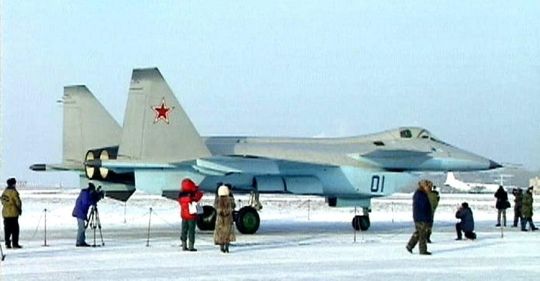
-Journalists photograph the MiG 1.44 during its roll-out in 1999. | Photo: Military Parade
Testing was again delayed, and the first flight did not occur until 29 February 2000. The flight lasted eighteen minutes, reaching a maximum altitude of 1,000 meters and a speed of 600kmh; test pilot Vladimir Gorboonov later described the aircraft as a docile flier. A second flight on 27 April the same year lasted twenty-two minutes, but apparently uncovered critical issues, allegedly with the engine, as no further test flights were undertaken. The 1.44 was retired to the Gromov Flight Research Institute, although it was later refurbished and displayed at the 2015 MAKS, 17 years after MiG originally requested it. Although never advancing beyond the initial test phase, the MiG 1.44 was given the NATO codename Flatpack, while the production 1.42, unofficially referred to as the MiG-35 or -39, was given the codename Foxglove.

-Rendering of a pair of production Foxgloves on patrol. | Illustration: Anynobody

-The Flatpack from head on, at the 2015 MAKS show. | Photo: Vitaly V. Kuzmin
youtube
#airplane#airplanes#aircraft#aviation#avgeek#cold war#cold war history#coldwar#ussr#soviet union#soviet air force#vvs#russian navy#russian air force#mig#mikoyan and gurevich okb#5th generation fighter#tech demonstrator#mig 1.44#mig 1.42#flatpack#foxglove#1980s#1990s#2000s#tsagi
18 notes
·
View notes
Text

Inaugural flight of the world's first fifth-generation fighter turns 25 years old
Fernando Valduga By Fernando Valduga 09/08/2022 - 22:40in History, Military
The F-22 Raptor fighter, the world's first fifth generation fighter, has reached 25 years since the first flight that occurred on September 7, 1997. Lockheed Martin released a video to celebrate the date.
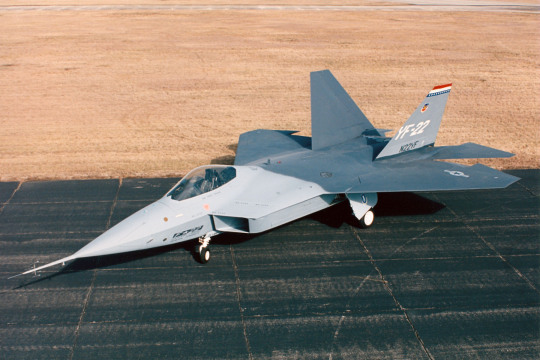
Lockheed-Boeing-General Dynamics YF-22. (Photo: U.S. Air Force)
The Raptor was an aircraft designed as a twin-engine platform to succeed the F-15 Eagle and the F-4D/E Phantom as the main air superiority fighter in the Western world. Developed under the Advanced Tactical Fighter Program, which began operating in the late 1970s, the F-22 project proposed by Lockheed Martin was chosen to the detriment of the F-23 rival developed by Northrop Grumman, and was considered the most conservative of the two, deviating less radically from the F-15.
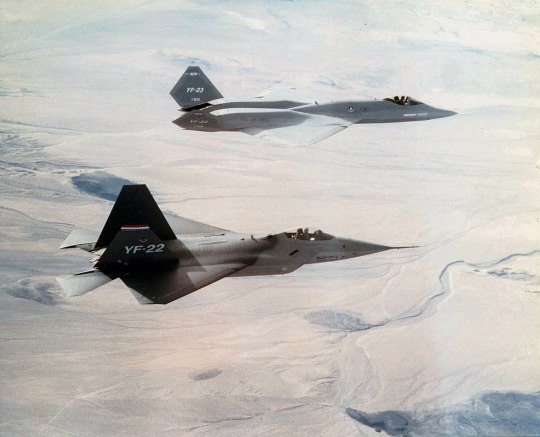
Northrop Grumman's YF-22 and YF-23.
The end of the Cold War in 1989, however, and the subsequent collapse of the fifth generation Soviet fighter programs after the disintegration of the state in the 1990s meant that the advanced tactical fighter was not expected to have a close competitor, which was considered an important factor that Northrop's most ambitious proposal was also probably much riskier and more expensive and therefore was not selected.

Prototype of the YF-22, called Lightning at the time.
If the USSR had not disintegrated, the MiG 1.42 program should see its first technology demonstrater fly in 1993-94, three to four years after its American rivals YF-23 and YF-22, with the aircraft sporting sensors and an engine significantly surpassing the power of its U.S. counterparts. Without the USSR, however, it would take decades for Russia to put a fifth generation fighter on the field - with the country not yet forming a full-size fifth-generation squadron, putting it two decades behind where the Soviet Air Force should be. While the fourth generation fighter of the Soviet Union, the Su-27, was evaluated in the US for having comfortably surpassed the performance of its American rival, the F-15, and was being produced on a comparable scale, the much poorer economy and technology sector of Russia after 1991 ensured that this feat would not be replicated in the fifth generation.
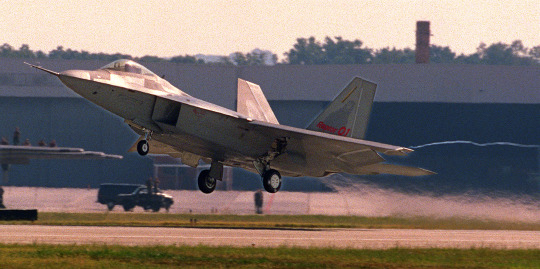
Fly the F-22 Raptor "01" on September 7, 1997.
Although the end of the Cold War and the Soviet collapse were highly beneficial to put the F-22 effectively in a league of its own, the strong contraction of American industry in that decade and reductions in defense spending undermined the program, leading to very significant delays. This included the tremendous seven-year interval between the YF-22 demonstrater's first flight and the first pre-production F-22, and more delays of more than eight years before the fighter gained initial operational capacity in the U.S. Air Force in December 2005. Upon entering service, the fighter was quickly recognized as problematic, with problems such as the 'Rur Raptor's cough', which significantly affected the health of its pilots, and the excessive maintenance requirements of the aircraft and the resulting low readiness rates, all of which harming its image.
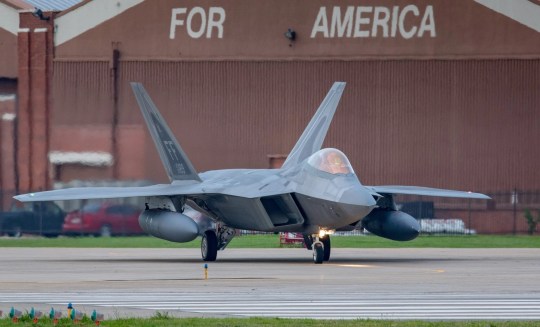
Some of the most serious problems with the F-22 concerned its avionic, with the fighter's computer architecture being effectively obsolete at the time it entered service due to very long delays in the program. 25 years after its first flight, the F-22 still cannot share data with other fighter units, which is a tremendous disadvantage in the age of network-centered war, and it cannot fire any The lack of features such as infrared search and tracking systems or distributed opening systems, seen in newer fighters, such as the lighter F-35 or the Chinese equivalent of the Raptor, the J-20, further impair the ability of the F-22 to remain relevant in the modern battlefield market.

The performance problems of the F-22 and, more significantly, its extreme operating costs and maintenance needs, have made it impossible to carry out up to half of the originally planned production, with production cut by 75% to only 187 fuselages. These cuts and the lack of economies of scale of greater production contributed to increasing costs, which per fuselage increased from US$ 149 million to an impressive US$ 412 million.

Orders to end production were given less than four years after the F-22 went into service, which reflected the seriousness of the problems with the program. To put this in perspective, the F-15 is expected to remain in production for more than half a century after being put into service, while the F-4 continued to be produced for 20 years after its entry into service.

Although there were frequent requests to extend or restart the production of the F-22, it became increasingly evident that the U.S. Air Force did not see a larger Raptor fleet as beneficial - with its performance problems and tremendous operating costs, making them among the least economical means of combat in the fleet. This was perhaps better demonstrated by the U.S. Air Force's decision to start retiring the F-22s in 2023, while continuing to buy more F-15, although the Raptors spent only a very small fraction of their useful lives. This showed that even with the F-22s already paid and years to fly, it was preferable to retire them and pay more to build new F-15 - the same aircraft they should replace.
Even so, the Raptor is capable of performing air-to-air and air-ground operations, enabling the full fulfillment of operational concepts essential to the U.S. Air Force in the 21st century, being an important component of the Global Strike Task Force, created to project air superiority quickly and over longer distances.
In September 2014, the F-22 Raptor made its combat debut in attacks coordinated with other fighters and bombers against Islamic State (ISIS) strongholds in Syria.
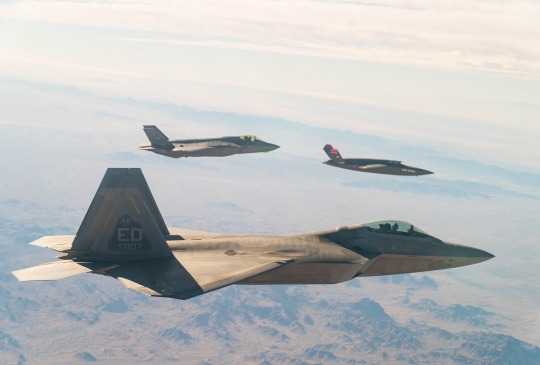
Lockheed Martin tweeted a message on September 7 to celebrate the 25th anniversary of the first F-22 flight.
The post was subtitled: "Authorized for takeoff! Celebrating 25 years of RaptorNation. The F22 flew for the first time on September 7, 1997, after six years of development. The Raptor continues to provide air superiority to our nation and allies and is a pioneer for the next generation of air dominance"

The company also posted a video on YouTube showing the first flight of the F-22 Raptor, which took place on September 7, 1997, in Marietta, Georgia.
youtube
Meanwhile, Boeing also posted a photo of an F-22 with the first 757 ever built, modified to serve as a flying test bench, to celebrate the 25th anniversary of the Raptor's first flight.
"Today marks the 25th anniversary of the first flight of the F-22 Raptor. The F-22 is portrayed in this publication of Innovation Quarterly Magazine, with the first 757 built and modified to serve as a flying test bench. The 757 still tests routinely alongside the Raptors," Boeing tweeted.

The U.S. Air Force also noted that this year marked the 25th anniversary of the F-22 Raptor. The aircraft routinely delivered to America and its allies fifth-generation air superiority, offering a combination of stealth, speed, mobility and powerful combat qualities, driven by two Pratt & Whitney F119 engines. Several extremely lethal sensors and weapons ensure air dominance, assisting in the mission.
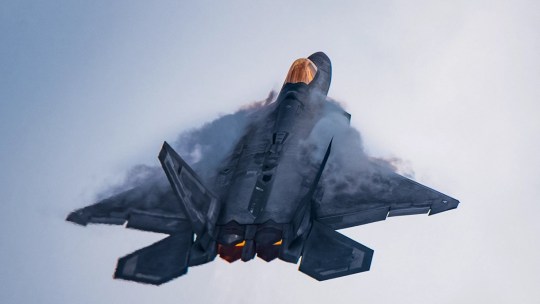
The F-22 program has reached some important milestones, including being the first stealth built for air-to-air combat, providing a technological springboard for the development of the F-35 and being the only Western fighter to integrate thrust vectorization engines for maneuverability.
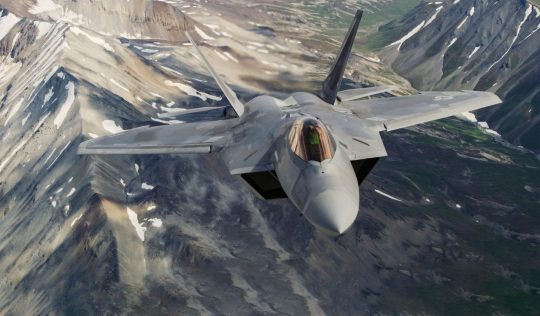
The program, however, seems very far from being successful a quarter of a century later, particularly compared to its Cold War predecessors and many of its competitors abroad, which became increasingly apparent as plans to retire the aircraft begin to materialize, confirming what was speculated a long time ago when orders to cut production were first made.

The U.S. Air Force plans to retire 33 F-22 Block 20 aircraft because they are mainly used for training and are not ready for combat. Preparing these F-22s for combat would cost $1.8 billion in eight years, which is an astronomical amount. With this, the Raptor fleet will be reduced to 153 aircraft if all retirements are approved. The U.S. Air Force does not plan to retire F-22 again until the Next Generation Air Dominance (NGAD) program is ready to replace it.
Tags: Military AviationF-22 RaptorHISTORYLockheed MartinUSAF - United States Air Force / US Air ForceUSAF/ATF - Advanced Tactical Fighter
Previous news
Belgium will buy a second A330 MRTT tanker, raising the MMU fleet to ten aircraft
Next news
RAF Voyager aircraft performs air-to-air refuelling training with Rafale jets from Qatar
Fernando Valduga
Fernando Valduga
Aviation photographer and pilot since 1992, he has participated in several events and air operations, such as Cruzex, AirVenture, Dayton Airshow and FIDAE. It has works published in specialized aviation magazines in Brazil and abroad. He uses Canon equipment during his photographic work in the world of aviation.
Related news
MILITARY
First batch of Checkmate jets will be produced in 2026
09/09/2022 - 16:00
MILITARY
Boeing demonstrates open architecture autonomy for manned and unmanned teams with MQ-25
09/09/2022 - 14:00
MILITARY
IMAGES: Italian Air Force performs Elephant walk with its training jets
09/09/2022 - 13:00
MILITARY
Airbus A330 MRTT from France replenishes a RAAF C-17 for the first time
09/09/2022 - 12:00
HELICOPTERS
Bell proposes technology transfer to manufacture AH-1Z in South Korea
09/09/2022 - 09:00
A Dassault Rafale of the Qatari Air Force performs air refueling operations with a Royal Air Force A330 Voyager over the central area of responsibility of the U.S. Air Forces on August 3, 2022. (Photo: U.S. Air Force / Staff Sgt. Charles T. Fultz)
MILITARY
RAF Voyager aircraft performs air-to-air refuelling training with Rafale jets from Qatar
09/09/2022 - 07:51
homeMain PageEditorialsINFORMATIONeventsCooperateSpecialitiesadvertiseabout
Cavok Brazil - Digital Tchê Web Creation
Commercial
Executive
Helicopters
HISTORY
Military
Brazilian Air Force
Space
Specialities
Cavok Brazil - Digital Tchê Web Creation
III
5 notes
·
View notes
Text
ماذا تعلم عن المقاتلة الروسية Mikoyan MiG 1.42
http://dlvr.it/RGhPsF
0 notes